This product has applications for many different home treatments.
What Do Bed Bug Bites Look Like?
It’s always unsettling to wake up from a long slumber and notice strange marks on your body. Or maybe you wake up to a strong itching or burning sensation on your back… But can’t quite see what the problem is. It’s natural to think that you have been bitten by insects in the middle of the night. But how do you know which insect? Without much thinking, people naturally gravitate toward the thought of bed bugs, and whether they need to be concerned. But before you jump to conclusions…. You should properly identify, diagnose, and prove that the bites you experienced were from bed bugs. Because if you seek medical treatment. Or try to remove an infestation….. You better make sure you’re not mistaking bed bugs for other, similar-looking insects. Bites require specific treatment and infestations require a specific process for removal. It’s critical that you understand what you’re up against before you take serious action. So on that note….. Let’s dive in.
Page Contents:
How to Identify Bed Bug Bites
- Slightly discolored, red dots (about the size of ¼ to ¾ inches in diameter.
- You see multiple bites in a row or in a zigzag pattern.
- You could see hives or a red circle on the skin that surrounds the bites.
If you’re having an adverse health issue like an allergic reaction from bed bug bites. Your bites may blow up to the size of 2 inches or more and turn into painful blisters .
Another problem is. After you have been bitten:
The bites DON’T always show up right away.
In fact, bites may not show up for days after you have been bitten.
(or even weeks in some cases)
If you suspect bed bugs but don’t have any bites to show for it….
You can look for the tell-tale signs that an infestation exists in your home.
Signs of Bed Bugs
Look for Colored Spots
You should check the mattress, box spring, and within your sheets for blood spots or bed bug droppings.
These spots will be a brown, reddish color and you should see multiple in one place.
Use Your Nose
Bed bugs have glands in their body that produce an unpleasant odor that’s sort of an unhealthy combination of musty and sweet.
When in large numbers….
The smell can be VERY strong.
If your bedroom consistently smells like a wet towel or a locker room, you may be able to identify an infestation without the physical signs.
Look for Eggs or Nymphs
Adult bed bugs can be hard to spot, but sometimes you can find bed bugs earlier in their lifecycle.
Female bed bugs can lay up to 12 eggs per day (500 in their lifetimes) so there are bound to be bed bug eggs that you can spot.
Eggs are small, without much color (maybe off-white).
You should also be on the lookout for nymphs.
Which are typically less nimble and slower than their adult counterparts.
Bed Bug Bite Pictures
Here are a few pictures of what bed bug bites look like.
Looking at cases of differing degrees of severity:
Mild Bites: In this case the victim has experienced a few bites in a cluster.
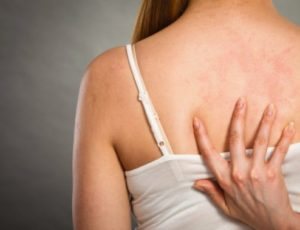
Mid-Tier Bites: Here we are seeing a high volume of bites, indicating a severe infestation was present.
It’s important to note that these bites are small/medium sized, and haven’t led to any severe skin reactions.
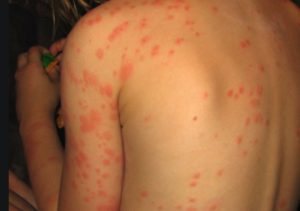
Severe Bites: Here you can see that the bites have grown to be 2 to 3 inches wide in diameter.
This is indicating a harmful skin reaction is present.
Bed Bug Bites vs. Mosquito Bites
Bed bugs and mosquitos have vastly different physical qualities, but their bites are often confused with each other.
Symptoms:
Mosquito bites are puffy white red bumps that occur a few minutes after bitten. With bed bugs, symptoms are more variable, and bumps may not show up for weeks.
Time to Heal:
Mosquito bites will heal up much quicker, typically within 2 to 3 days.
While bed bugs bites persist for much longer.
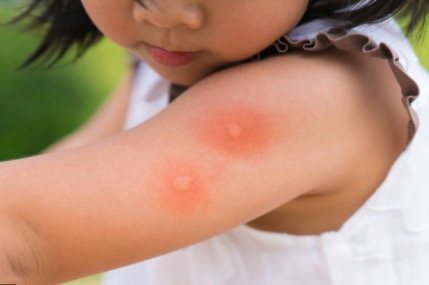
Where They Bite:
Mosquito bites are usually distributed throughout the body in areas of exposed skin. This includes the legs, face, back, neck, arms etc.
Bed bug bites are more clustered and occur in a distinct pattern .
Bed Bug Bites vs. Flea bites
Symptoms:
You’ll typically feel a Flea bite instantly after being bitten.
Both bed bug and Flea bites can cause inflammation, which can lead to noticeably larger welts than what would occur from other insect bites.
Where They Bite:
You can expect to find Flea bites on your lower body, that appear in random groupings.
Bed bug bites are more commonly in a straight line (or zig zag pattern),
Whereas Flea bites will occur in random looking clusters.
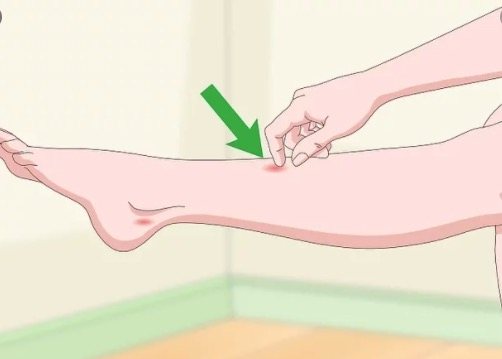
Dangers:
If you’re allergic to fleas, you could develop hives or a rash, similar to being allergic to bed bugs. The difference is that fleas are much more likely to cause a skin infection.
A common infection is called Tungiasis.
(Yes, it’s hard to pronounce)
This infection almost always occurs between the feet and toes .
Certain Fleas will dig under your skin to feed, which leads to this very complicated infection.
Bed Bug Bites vs. Hives
Bites from bed bugs are often mistaken for hives, mainly because they both stem from an allergic reaction.
It’s critical that you’re able to tell these 2 skin conditions apart because…
They each require different types of treatment.
Size:
Bed bug bites will be fairly consistent in size and hives can be across the board. Some hives can look as big as a quarter or as small as a pimple.
Color and Shape:
While bed bug bites are consistently red, the color of hives will vary, from either pale to dark red.
Bed bug bites are usually perfectly round, while Hives can have more diverse, uneven looking shapes.
Location:
Bed bug bites can only occur in places that your skin is uncovered .
Your neck, arms, legs, or face.
Hives can occur anywhere on your body, it makes no difference whether your skin is covered or not.
How To Diagnose Bed Bug Bites
To fully diagnose a bed bug bite, you must look beyond the symptoms.
These bites can be easily confused with other insects or skin reactions, so it’s important to look at…
These 3 different factors when diagnosing your bites:
History
To determine whether bites are from bed bugs, it helps to look into the history of bed bugs in the site that you were bitten.
If you were bitten in an apartment complex, You should see whether your neighbors have had any previous or active infestations.

Though, people stay pretty quiet about their infestations…
So you can also look into public record for any landlord-tenant disputes that may have occurred at your rental property.
You should also ask yourself:
If you moved into a new home, has the home has a history of infestations?
Home Inspection
Has your bedroom been properly inspected for an active infestation?
It’s important that a professional inspect your home thoroughly for signs of bed bugs.
This includes areas such as
- The bedroom (including mattress/box spring, bedding, bed frame)
- Walls and baseboards
- Behind furniture
- Any other cracks or crevices within your home

The Appearance of Bites
Though bed bug bites can easily be confused with other insects, a doctor should be able to diagnose your bites when looking closely.
Bed bug bites have a unique shape, and pattern, that a skilled physician should be able to identify.
Mild Bed Bug Bites
It’s impossible to predict whether a person will have a mild or severe reaction to bed bug bites.
Because everybody’s skin reacts differently, so the range of outcomes is extremely wide.
More often than not, symptoms of bites are fairly mild. Meaning you’ll experience some irritation for a few days along with unsightly red bumps or welts on your body. Bites like these are a light inconvenience but will not upend your life or debilitate you as a severe reaction would.
Keep in mind that…
Even if a bed bug bite starts off as mild, it can turn more serious fairly quickly.
Here are a few ways that can happen.
One is if you scratch the bites – it can lead to more severe symptoms like:
- Intense burning or itching.
- Bleeding or open wounds.
- Scarring (in rare cases you may get keloid scars).
Bites can also turn more serious if you have other skin reactions while you currently have active bites on your body. Whether it’s a generic rash, or a breakout of hives, these types of reactions can exacerbate existing bites.
Here are some pictures of mild bed bug bites:
Below is a picture of a toddler who was bitten a few times on his ankles and feet.
(Click here for more information about how bed bug bites affect children).

Below is a picture of a slightly more severe reaction.
(Although still considered mild).
Here you can see a woman who has around 10 bites on her back.
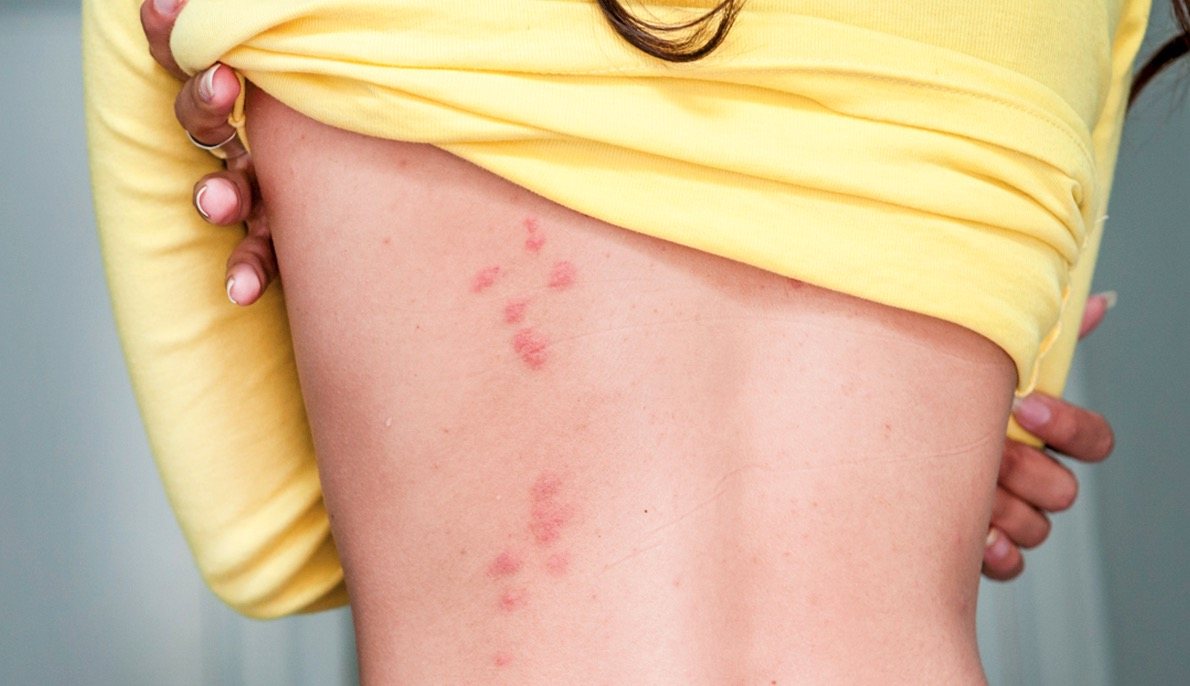
How Long Do Bed Bug Bites Itch?
Bed bug bites can itch anywhere from 3 to 10 days. The extent and longevity of the skin reaction is highly dependent on the individual and how they treat their bites. If an individual treats their bites with medication and care, then bites will disappear much more quickly.
Here are a few treatment methods to help relieve symptoms and help bed bug bites heal faster.
Calamine Lotion: This is a medicated anti-itch lotion that can be applied multiple times per day to relieve symptoms.
Antihistamines: You can take antihistamines orally to help reduce itching or any burning that’s occurring. This is an effective method when you’re experiencing disturbed sleep due to physical symptoms or anxiety from bed bugs.
Advil or Tylenol: Over the counter pain reliever medication can help reduce pain and any swelling that may occur from the bites.
Stick with reputable medications to help alleviate bed bug bites so that they go away quicker.
If after a few weeks your bites still haven’t gone away…
You should contact a doctor or health professional to evaluate your skin.
How Long Do Bed Bug Bites Last?
The length of time a bed bug persists on skin will depend on the individual.
Since a bite can take up to TWO weeks to show on up on skin, the consensus is they take around:
10 to 14 days to disappear.
Although, those with more sensitive skin….
Will see bites in less than an hour after being bitten, and it could take up to 30 days for the bites to full disappear.
In more severe cases, victims develop anaphylaxis and require immediate medical attention.
Others (the lucky ones), may not notice or even experience bites at all.
Bites will last longer if any of the following occurs:
- Aggressive scratching: This can cause scarring and also cause the wounds to fester and burst.
- When left untreated: Bites do eventually go away on their own, but certain treatments will help accelerate the healing process. In fact, Pinterest has a board with 27 natural home remedies for bed bugs.
- Infection: If the bites turn into open wounds which then become infected, this will cause your bites to last a lot longer.
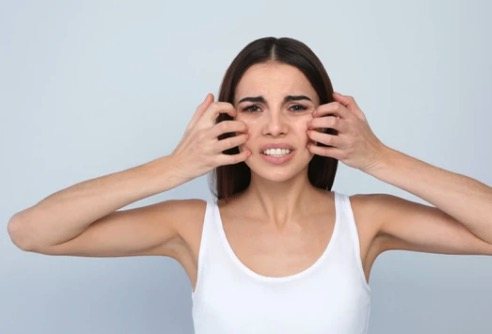
Bed bug bites typically last much longer than other insect bites like mosquitos.
You’ll need to be patient as your bites heal, and try to fight the urge to scratch and further irritate your wounds.
The fact that these bites persevere so long, is one of the main reasons that bed bugs can lead to long term psychological issues within victims.
How to Treat Bed Bug Bites Naturally
Bed bugs will target the areas of your skin that are exposed while you’re asleep.
Once you have been bitten, you should wash the area with soap and water.
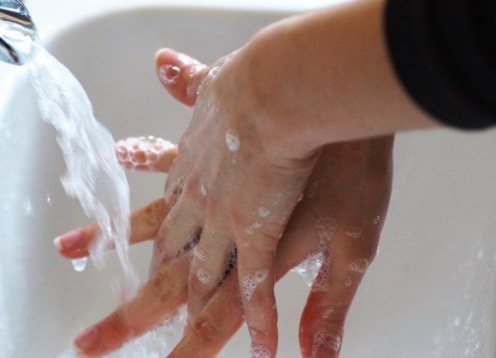
Once the areas around the bites are clean.
You can try the following natural treatment options:
Salt
This is a natural bacterial agent and can help reduce the size of rashes and inflammation caused by your bites. Applying some light salt on the affected area may provide some relief to the irritated skin.
Try this method 3 times per day (and continue as needed)
Toothpaste
Most toothpaste products contain Menthol, which will naturally cool the skin around the bite. This especially works if you feel a burning sensation coming from the affected skin.
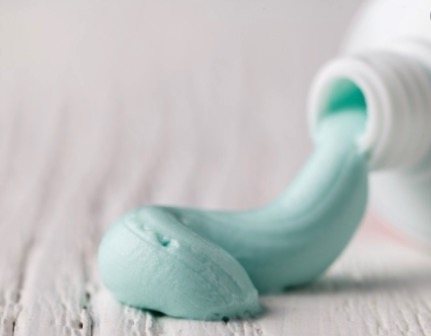
Apply a dab of toothpaste on the affected area and rinse away after 10 minutes. Repeat this process a few times a day.
Ice Packs
Ice is known for its ability to numb your skin.
(specifically, your nerve endings)
And provide relief to a burning or itching sensation.
Ice is also great for reducing swelling or inflammation that can result in more serious reactions to bed bug bites.
Take your ice pack and apply it to the affected area for 10 to 15 minutes max.
Continue to repeat the process as needed.
Apple Cider Vinegar
This product has applications for many different home treatments.

It has the capacity to be:
- An antiseptic
- Antibacterial
- Anti-inflammatory
- Antifungal
To heal bed bug bites with apple cider vinegar, simply soak a cotton ball with this vinegar and apply it to the bites.
Feel free to reapply up to 5 times per day as the symptoms persist.
Can Bed Bug Bites Kill You?
A lot of talk goes around when it comes to bed bugs.
People spread rumors resulting in myths about bed bug symptoms and certain DIY methods of treatment that may or may not work..
The short answer to this question is:
NO. Bed bugs will not kill you.
More often than not bed bugs only cause light skin irritation.
Now there are situations where people can have adverse reactions to bed bugs, that in VERY rare circumstances may lead to death.
Although this would have to be due to a serious preexisting condition .
At the end of the day, bed bugs typically won’t cause physical harm, if anything they do more emotional damage than physical.
Check out the video below for 7 important things to know about bed bugs.
Summary
There are many traits that can indicate whether a bite is from bed bugs.
The infographic below contains a complete breakdown of the different characteristics of a bed bug bite.
What Do Bed Bug Bites Look Like? Bed Bug Bite Pictures, Symptoms, and Treatments
If you wake up with a line of three to four itchy, swollen bumps, it could be due to bed bugs.

By Brielle Gregory Updated: May 25, 2022
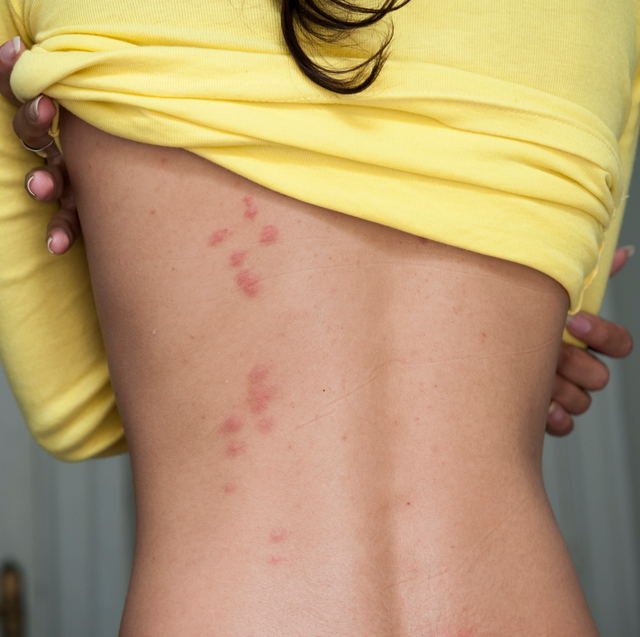
Joel Carillet // Getty Images
Waking up with a fresh set of itchy bug bites can bring on its own set of worries. What, exactly, was biting you in the middle of the night? Was it a spider? A mosquito? Or—possibly the worst case scenario—could it have been bed bugs?
Although bed bugs might not be the first thing we think of when we wake up with an itchy or painful welt, the critters do get their food from our blood—and will leave a little red bump after getting their fill.
But the trouble with identifying a bed bug bite—as is true for a lot of insects, including mosquitoes—is that it can be hard to identify the source, as not everyone’s immune response is the same. “Everybody’s going to respond differently,” says Timothy Gibb, Ph.D., a clinical professor of entomology at Purdue University. “Same thing’s true with a mosquito bite. Some people are going to swell up and it’s going to itch. That same mosquito could bite someone else and it’s hardly noticeable.”
In fact, Gibb says some people’s skin doesn’t respond to a bed bug bite at all, which is especially the case for the elderly population. That’s why it can be difficult to determine if your bite is from a bed bug just by looking at it.
However, there are a few things that can tip you off to the fact that bed bugs are the culprit of your bites. Here’s what to know, including bed bug bites pictures to help you visualize the symptoms.
What do bed bug bites look like?

Joel Carillet // Getty Images
The key bed bug bite symptom to look for is a red, raised bump, says Gibb, similar in appearance to a spider or mosquito bite. But what sets bed bugs apart from other insects is that oftentimes, their bites will present in a line or cluster on one part or side of your body. This is the result of what’s called “probing.”
Bed bug bites show up in a line, most often in a cluster of 3 to 4 bites.
“They probe the skin in several different places, I think probably to find best access to draw blood,” says Gibb. In fact, if you have screens on your windows—thereby keeping out other insects that might bite—but are still waking up with a line of 3 or 4 bites on your arm, it’s safe to suspect that bed bugs might be to blame, says Edwin Rajotte, Ph.D., a professor of entomology at Penn State University.
Where do bed bugs hide?
Another way to determine if your bites come from bed bugs is to look for the insects themselves. They naturally like to hide in your mattress, especially in the corners, near the head end, and in the cord that goes around it. They also like to camp out behind the headboard, behind any pictures on the wall, and in electrical sockets.
Adult bed bugs are about the size of an apple seed and are very flat from top to bottom—almost as thin as a piece of paper—with a brownish color, says Rajotte. Baby bed bugs are also brownish in color, but pinhead-sized. Another key identifier? Look for black spots on your sheets, mattress, and mattress cover, which could be bed bug feces.

John-Reynolds // Getty Images
When and where do bed bugs bite?
Bed bug bites will most commonly occur on the arms, neck, or trunk of the body, says Gibb, although they’ll bite anywhere they can find exposed skin. And—as their name suggests—bed bugs will bite you at night while you’re sound asleep.
“We’ve found it’s most active when people are most sound asleep, and that’s usually from about 2:00 to 4:00 in the morning,” says Gibb. “That’s natural for a parasite like that to do that because it’s going to protect it. People won’t see it, they won’t feel it. It makes their survivorship much more probable.”

Joel Carillet // Getty Images
According to Changlu Wang, Ph.D., extension specialist in entomology at Rutgers University, bed bugs typically feed every two to three days when a host is present, so if fresh bites appear in such a frequency, the timing could be another indicator of their presence.
How to treat bed bug bites
If you’ve been bitten and have the insatiable itch, chances are, you’re going to want to speed up the treatment process. Unfortunately, the best way to do that is also the hardest way to do it: not scratching the bite, says Gibb, which will just further irritate the area.
If you’re having trouble keeping your claws off, you can also try using an antihistamine—think Benadryl or Allegra, which are meant to curb allergy symptoms—to help mute that itchy feeling.
Related Stories
And if bed bugs are the cause of your bites, realize there’s no urgent need to panic. Yes, they might cost you a pretty penny and can be a pain to get rid of, but bed bugs can’t do any serious damage to your body. “They don’t kill people,” says Gibb. “A parasite would have a hard time surviving if it killed its host, and these do not.”
In fact, they don’t even transmit anything dangerous to you. “They’ve never been shown to transmit any diseases,” says Rajotte. “Unlike mosquitoes and ticks and things, which can transmit some pretty bad diseases, bed bugs do not. And so while they’re annoying and all that, they’re not going to harm your children or anything like that. They’re just annoying and you need to get rid of them.”
Are bed bug bites itchy? Do they hurt?
Although some people will say a bed bug bite hurts somewhat—though not as intensely as the sting of a bee, for example—most complaints are due to the itching the bites cause, says Gibb. And that itching is due to the chemicals the bed bug inserts into your body during the bite, adds Rajotte.
“They’ve become what I consider the perfect parasite, because their mouthparts are kind of interesting,” says Gibb. “They will inject an anesthetic prior to biting, so people won’t feel it. And then they inject an anticoagulant that allows the blood to run easier for them to suck that up.” So while that system works great for the bugs, those left-over chemicals will usually lead to some uncomfortable itching on your end.

Joel Carillet // Getty Images
How long do bed bug bites last?
Although the duration and intensity of a bed bug bite will hugely vary from person to person, you typically won’t feel the effects of a bed bug bite—like itching and those raised red bumps—until mid-morning after a bite due to the anesthetic the bug injects, says Gibb.
Pictures of Bed Bug Bites
This page may contain affiliate links to products we recommend, researched and love. If you decide to make a purchase after clicking one of these links, I’ll earn some coffee money which we promise to drink while writing more helpful content like this. We do not recommend any product we wouldn’t use ourselves.
Overview
Each of the following pictures of bed bug bites shows typical skin reactions to the insect’s saliva. Most people are not hypersensitive to the bites and will show no reaction at all with the exception of two small dots where the bedbug punctured the skin. Other people can develop more severe symptoms such as red papular eruptions (raised inflamed areas) or in severe cases, blisters.
Most bites will have a small clear area in the center surrounded by redness that may or may not be raised. People tend to become more sensitive and have larger reactions after each episode. Reactions can include itch, swelling, rash, and wheals (large round red area on the skin). Severe reactions can cause skin blisters and trouble breathing, although these reactions are very rare.
Skin reactions can occur immediately, hours, days or even up to two weeks later. Itch, the primary symptom beyond a red raised area, should subside in 1 to 3 days. Bed bug bites should go away with no treatment in 4 to 7 days.
Because individual allergic skin reactions can vary as shown in the following bed bug bite images, and people can become more or less sensitive to bed bug bites over time, bites alone cannot confirm the presence of bed bugs. Also look for other factors such as actual insects or blood and fecal stains on a mattress. Research shows that 11 out of 24 people have no reaction when first bitten. However, when bitten again most developed a skin reaction. (1)
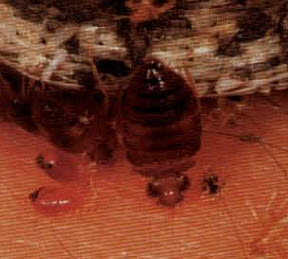
Picture of Bed Bug Feeding on Skin. Adult Bed Bugs are About the Size of an Apple Seed
If you skin symptoms match any of the pictures of bed bug bites, look for other signs of an infestation.
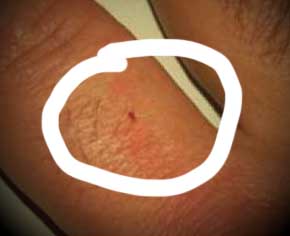
Bed Bug Feeding On Hand
Pictures of Bed Bug Bites on Humans
When people ask “show me pictures of bed bug bites” they are often thinking that all bites look the same. The reality is that reactions are different in each person.
Bed bugs bites will appear on areas of the body that are exposed during sleep. The most common areas are the legs, arms, shoulders, and neck. The bite itself will feel like a tickle or pinch. Patterns are often in a straight line.
Said another way, if you see bites only under areas that are covered in clothes, and you see no other signs of an infestation such as live insects or mattress stains, in all likelihood the skin reaction you are seeing IS NOT caused by bed bugs.
Do not scratch the bites as it can cause a skin infection. Bite reactions can occur immediately or in a few days.
Typical Allergic Skin Reactions
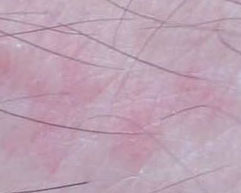
Bed Bug Bite Skin Reaction After 30 Minutes on Lower Leg
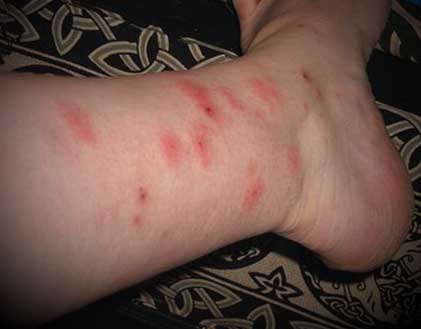
Bed Bug Bites on Leg
Bed Bug Bite Patterns
It is common to see bed bug bites in a row of 3 or 4 bites or a cluster. This could be due to an arm or leg resting on an infested mattress seam.
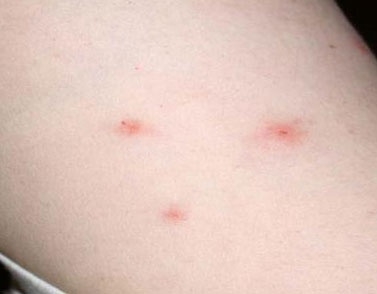
Bed Bug Bite Pattern on Arm
Bed bug bites can appear individually, in groups or in rows.
What do Bed Bug Bites Look Like on Arms?
Bed bug bites most commonly are found on exposed skin areas during sleep such as the lower legs, shoulders, and arms.
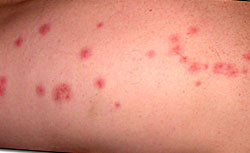
Cluster of Bed Bug Bites on Arm
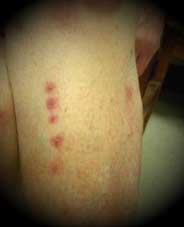
Bed Bug Bites In a Row. Could be caused by leg leading against mattress seam where bedbugs are hiding.
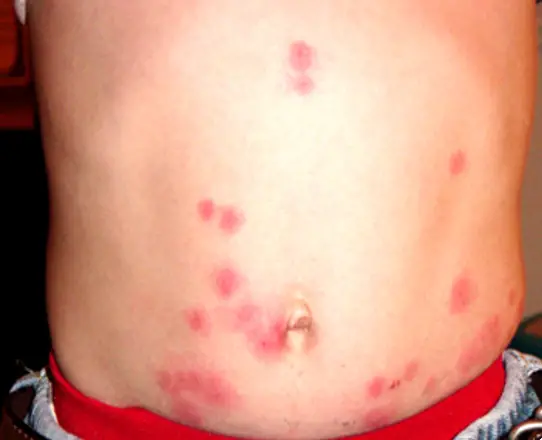
Bed Bug Bites on Stomach. Bites are typically 2mm to 5mm. Bites are referred to as erythematous ( redness of the skin or mucous membranes due to the accumulation of blood in dilated capillaries) or maculopapular (flat, reddened area of skin present in a rash) lesions.
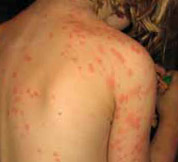
Back of 4 Year Old Bitten by Hundreds of Bed Bugs. Quantity of Bites Make Skin Look Like a Rash Instead of Bites
Bed Bug Bite Wheal Skin Reaction
The Bed Bug bite wheal pattern see below is usually seen in people that that have had other bed bug bite episodes and are now more sensitive to the bites.
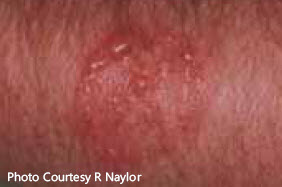
Bed Bug Skin Wheal Reaction
Author: R. Naylor
The size of the skin reaction depends on the allergic response of the individual. Hypersensitive individuals will have larger reactions.
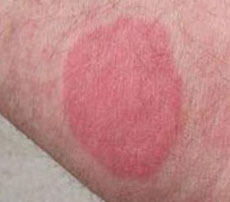
Bed Bug Wheal Skin Reaction
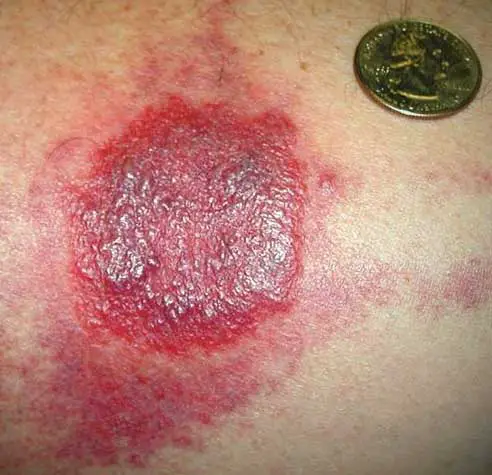
Bed Bug Bite on Leg – Wheal Reaction
Blister Reaction
In advanced cases bed bug skin reactions can turn into blisters.
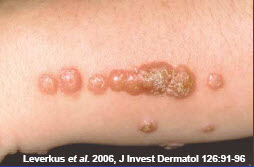
Picture of Bed Bug Skin Blisters
Author: Leverkus
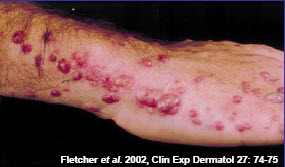
Bed Bug Bite Blisters Hypersensitive Reaction
Stages of Bed Bug Bites
Bed bug bite images vary based on the individual and how allergic they are.
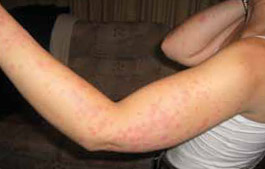
Bed Bug Bites 4 Days After Being Bitten
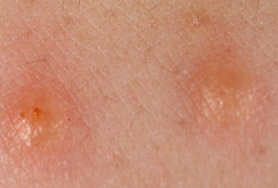
Bed Bug Bite 1 Week After Being Bitten on Skin
Diagnosis
- Chicken Pox
- Staphylococcus infection
- Spider or Mosquito Bites
- Hives
- Allergies to food
- Reaction to medications such as antibiotics
- Scabies
Bed Bug Bites Treatment
Treatment for bedbugs bites involves addressing itchy bites, soothing the skin, and then preventing any infection. After Bite makes an anti-itch anti-microbial gel formula that is specifically formulated to provide relief bed bug itching and to promote healing.
In most cases, medical attention will not be needed if you have been bitten. For severe reactions or if you have difficulty breathing, immediately seek emergency medical care.
If the bed bug bites aren’t healing, or you see signs of puss or infection, be sure to see a Doctor.
Tell-Tale Signs of Bed Bugs
Do not rely only on bite symptoms when determining if you have a bed bug infestation. Bed bug bites look like bites from other common insects. Skin reactions can be caused by insect stings from fire ant stings, insect bites from spiders, mosquito bites, and scabies to name a few. Other causes include skin irritation from exposure to household chemicals or some type of allergy.
- Pattern: Middle of the bite is clear with a red ring around the middle.
- Symptoms: Most bites are very itchy
- Location: Bed bugs do not bite through clothing and only bite exposed skin. This includes the arms, legs, shoulders, and neck. Bites are rarely seen on the bottoms of the feet. If this is the location of the bite, see a doctor and ask if the condition is scabies.
- Presence of Actual Bed Bugs: You can see baby bed bugs and adult bed bugs with the naked eye. Use a credit card or thin brush to work through the mattress seam to see if you dislodge any insects. It might be helpful to have a flashlight and magnifying glass. You can also spot small overall off-white bed bug eggs attached to rough surfaces. Note that bed bugs can change in appearance as they absorb human blood.
- Signs on the Mattress: Small brown spots on a mattress (bed bug feces) or small blood spots could indicate the presence of bed bugs. Of course, spotting the bugs themselves is a sign. They hide in the seams of the mattress. Even one bed bug can cause a problem. Other areas where bed bugs are commonly found include around the headboard, night tables, and crevices between the walls and floor.

Picture of Bed Bug Stains on Mattress
Why You Need a Bed Bug Professional
Do not only rely on pictures of bedbug bites to confirm that bed bugs are your problem. For example, bites that occur only on the bottoms of the legs are more likely to be flea bites.
Call in a professional that knows how to spot an infestation that might be in the walls of your home or hidden in a bed frame.
We recommended using the exterminators registered with Home Advisor. You can also call eLocal at 1.877.673.2704 for a pest control expert near you. Members of these networks are licensed and reviewed. There is no charge to receive a quote. You can also look at our directory of bed bug pest control experts.
Protect Yourself From Bed Bugs
Until you treat your home, minimize bare skin to cut off the bed bugs’ food source. At night wear socks over the bottom of pajamas and mittens over shirt sleeves. Keep your bed away from other furniture and blankets off the floor.
Brochures
Each of these free brochures is filled with pictures of bed bug bite examples such as photos of rashes, skin reactions, mattress signs, and information.






